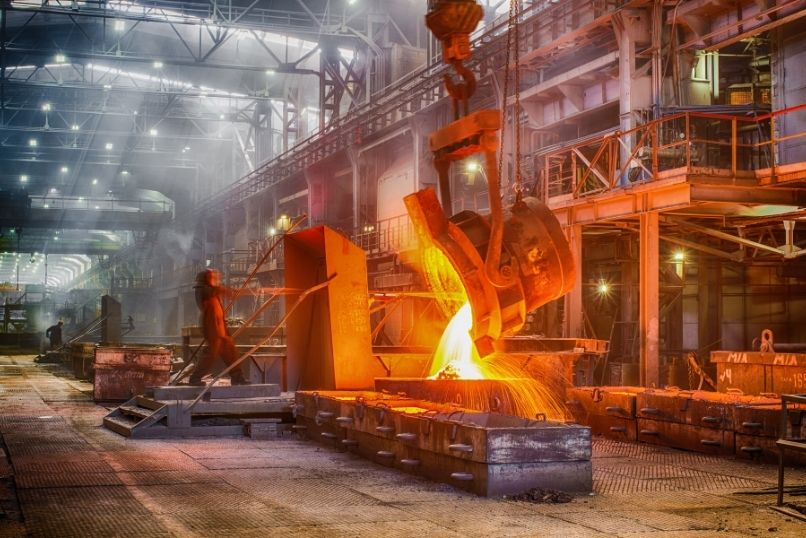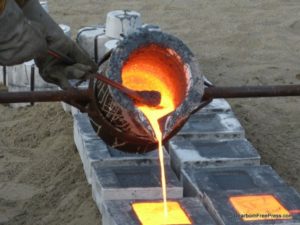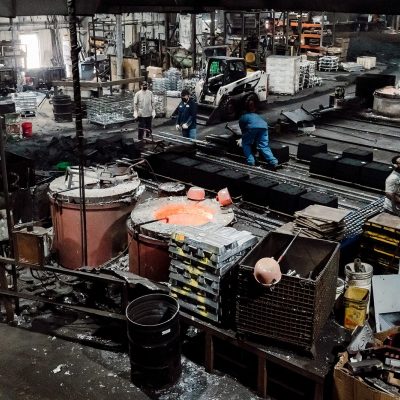How Aluminum Castings achieve precision through refined techniques
Wiki Article
Understanding the Metal Castings Refine: A Comprehensive Guide for Beginners
The Metal Casting process is a basic strategy in making that transforms molten metal into solid forms. Newbies must comprehend the numerous methods entailed, such as sand spreading and pass away spreading. Recognizing the products, design concepts, and precaution is just as vital. Each element plays an essential duty in attaining effective end results. As one navigates these ins and outs, the question of exactly how to enhance each step for enhanced outcomes ends up being progressively essential.The Fundamentals of Metal Casting
Although Metal Casting has advanced over centuries, its basic principles stay constant and essential to the production process. At its core, Metal Casting includes the improvement of molten steel right into solid objects through numerous techniques. The procedure begins with the development of a mold and mildew, which defines the form of the last item. Once the mold is prepared, metal is warmed to its melting point and poured right into the cavity. After cooling, the metal solidifies, taking the shape of the mold.There are several casting methods, consisting of sand spreading, investment casting, and die casting, each with one-of-a-kind benefits and applications. The option of technique relies on factors such as manufacturing quantity, material kind, and desired accuracy. When cast, the end product might undertake additional processes like machining or surface treatment to achieve the called for finish and requirements. Recognizing these basics is crucial for anyone thinking about the field of Metal Casting.

Comprehending Products Made Use Of in Steel Casting
Materials play an important role in the Metal Casting procedure, affecting the end product's residential properties and performance. Different metals are made use of, including aluminum, iron, bronze, and steel, each offering distinct characteristics fit for particular applications. Aluminum is lightweight and corrosion-resistant, making it excellent for vehicle parts. Iron, specifically cast iron, is favored for its outstanding wear resistance and durability. Steel provides high strength and adaptability, frequently made use of in heavy equipment elements. Bronze, understood for its deterioration resistance and machinability, is typically employed in marine applications.In enhancement to the steels, various casting materials, such as sand, plaster, and ceramic, are used to develop molds. Sand spreading, one of the most widespread approach, makes use of silica sand due to its thermal stability and capability to form complex shapes. Plaster and ceramic mold and mildews offer better information yet might call for even more complicated procedures. The option of materials straight influences the effectiveness, cost, and top quality of the casting operation.
The Design Process: From Principle to Plan
The style procedure in Metal Casting begins with the initial concept advancement, where concepts are produced and reviewed. This is complied with by the application of CAD modeling strategies, permitting for accurate visualizations of the style. The blueprint finalization steps ensure that all requirements are properly recorded for production.First Idea Growth
Preliminary concept development marks an important stage in the Metal Casting process, where ideas transform into concrete designs. Throughout this phase, developers team up with stakeholders and designers to brainstorm and improve first principles. They think about aspects such as performance, aesthetic appeals, and manufacturability, ensuring that the style meets the called for specs and efficiency standards. Sketches and outlines are produced to imagine the concepts, enabling for preliminary evaluations of usefulness and cost-effectiveness. This stage additionally involves recognizing products and possible casting approaches that line up with the design goals. Eventually, first concept growth prepares for an extensive plan, guiding the subsequent stages of the spreading process and making sure a successful shift from concept to truth.CAD Modeling Techniques
Transforming ideas right into accurate styles, CAD modeling strategies play an essential role in the Metal Casting process. These strategies utilize sophisticated software program to create in-depth three-dimensional models that precisely reflect the intended product. By employing devices such as parametric modeling, strong modeling, and surface modeling, designers can control measurements and forms easily. CAD systems likewise facilitate simulation and evaluation, permitting for the identification of potential imperfections before manufacturing starts. This positive strategy decreases product waste and maximizes the style for manufacturability. Additionally, CAD models can be easily customized, enabling fast models based on feedback. Fundamentally, CAD modeling acts as the foundation of the layout procedure, connecting the void in between initial ideas and the ultimate production-ready designs.Blueprint Finalization Tips
Complying with the development of comprehensive CAD designs, the following phase entails blueprint completion, which is critical in translating electronic designs into workable plans for manufacturing. This process starts with assessing the CAD models for accuracy and compliance with specs. When validated, the dimensions, resistances, and product specs are carefully outlined to ensure clearness. Integrating notes and notes helps communicate important details relating to spreading processes, surface area finishes, and assembly needs. The completed plan undergoes an extensive approval procedure, typically including cooperation with designers and manufacturing teams to resolve any kind of prospective issues. Revisions are made and approvals gotten, the plan is officially launched, serving as the fundamental file for the succeeding phases of Metal Casting, including pattern making and mold style.The Metal Casting Methods Explained

Metal Casting techniques include a range of approaches used to shape molten metal into preferred kinds. These techniques vary according to the sort of material, complexity of the layout, and manufacturing volume. Sand spreading is one of one of the most usual methods, entailing the creation of a mold and mildew from sand to hold the molten steel. Financial investment spreading, or lost-wax casting, allows for detailed styles by utilizing a wax pattern that is dissolved. Die casting utilizes high-pressure injection of molten steel right into a mold, appropriate for automation. Various other methods consist of permanent mold and mildew spreading, which makes use of reusable mold and mildews, and centrifugal spreading, where rotational pressures assist in filling up the mold and mildew. Each technique has its advantages and applications, making it important for suppliers to choose the suitable method based upon their specific requirements and requirements. Comprehending these techniques is necessary for any individual associated have a peek at this website with the Metal Casting procedure.
Ending Up Processes: Enhancing Your Casted Product

Completing processes play a vital role in enhancing the top quality and appearance of casted items. Various surface treatment techniques, such as polishing and layer, are employed to boost toughness and looks. Additionally, high quality inspection techniques guarantee that the end product fulfills defined standards and performance requirements.
Surface Area Therapy Methods
A variety of surface therapy techniques play an essential role in improving the high quality and long life of casted items. These strategies consist of approaches such as shot blasting, brightening, and finish. Shot blasting efficiently eliminates surface area flaws, boosting the functional and visual qualities of the spreading. Polishing offers a smooth finish, which is especially crucial for attractive applications and parts calling for very little rubbing. Coating strategies, such as electroplating or powder finishing, deal added defense against rust and wear, ensuring durability. In addition, surface therapies can enhance bond for subsequent procedures, such as painting or bonding. By utilizing these methods, suppliers can accomplish exceptional surface area high quality, which is important for the performance and life expectancy of Metal Casting in numerous applications.High Quality Inspection Methods
Reliable high quality inspection techniques are crucial for ensuring the integrity and performance of casted products after the ending up procedures. Various strategies are employed to analyze the quality of Metal Casting, consisting of visual evaluation, dimensional checks, and non-destructive screening (NDT) Aesthetic inspection permits the identification of surface area issues, while dimensional checks assure that products meet specified tolerances. NDT approaches, such as ultrasonic testing and radiographic inspection, supply much deeper understandings into interior stability without harming the spreadings. In addition, mechanical screening, such as tensile and hardness tests, evaluates product homes - Aluminum Foundry. By using a mix of these approaches, suppliers can enhance product quality and dependability, inevitably leading to greater consumer satisfaction and decreased production expensesSecurity Considerations in Metal Casting
While the Metal Casting process uses various benefits, it likewise provides a series of security risks that must be carefully handled. Employees in casting centers are exposed to heats, liquified metals, and harmful materials, which can bring about serious injuries if correct precautions are not taken. Individual safety equipment (PPE) such as heat-resistant handwear covers, encounter shields, and protective clothes is essential to minimize threats.In addition, the existence of fumes and dirt demands proper air flow systems to guarantee air quality - Wisconsin Aluminum Foundry. Normal training on security procedures is vital for all employees to acknowledge prospective hazards and respond successfully. Emergency procedures ought to be established, including fire safety actions and emergency treatment accessibility. Upkeep of devices and appropriate handling of products additionally add to a safer working setting. By prioritizing these security factors to consider, Metal Casting operations can protect their workforce and preserve efficient production procedures
Regularly Asked Concerns
What Are the Ecological Impacts of Metal Casting?
Metal Casting can result in environmental find more info influences such as air and water pollution, resource deficiency, and power intake. Furthermore, improper waste administration and emissions from factories add to environmental disruptions and health risks for close-by communities.Just how Do I Select the Right Steel for Spreading?
To select the right steel for spreading, one must think about factors such as mechanical properties, deterioration resistance, thermal conductivity, and expense. Assessing the desired application and environmental problems is vital for ideal choice.What Are the Common Problems in Metal Casting?
Usual defects in Metal Casting include porosity, contraction, sand addition, and misruns. These problems frequently develop from incorrect product selection, insufficient style, or imperfections in the spreading process, impacting the end product's top quality and efficiency.
Exactly How Can I Improve My Steel Casting Skills?
To improve Metal Casting abilities, one ought to exercise regularly, research spreading techniques, examine previous projects for issues, look for feedback from skilled casters, and continually experiment with various materials and approaches to improve effectiveness and understanding.What Is the Expense of Beginning a Metal Spreading Organization?
Starting a steel casting company generally needs a preliminary financial investment of $5,000 to $50,000, depending on tools, materials, and center costs. Factors like area and scale can substantially affect general startup expenditures.The Metal Casting process is a basic strategy in manufacturing that transforms molten steel right into strong forms. Novices should grasp the numerous techniques entailed, such as sand casting and pass away casting. There are a number of casting approaches, consisting of sand casting, investment casting, and pass away casting, about his each with unique advantages and applications. Financial investment casting, or lost-wax casting, enables for detailed layouts by utilizing a wax pattern that is melted away. Various other methods include irreversible mold casting, which uses recyclable molds, and centrifugal spreading, where rotational pressures help in loading the mold.
Report this wiki page